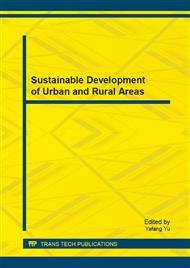p.841
p.845
p.851
p.855
p.859
p.864
p.869
p.874
p.880
Research on Eco-Economy System of Shanghai Pudong New Area Based on Emergy Analysis
Abstract:
Based on emergy analysis, this paper studied the emergy flow in the eco-economy system in Shanghai Pudong New Area from 1995 to 2011 and analyzed the relationship between the environment stress caused by the development of economic and the sustainable development of the area from the perspective of nature-social-economic ecosystem. The results show that the development of the area depended mainly on the nonrenewable emergy resources, the largest percentage of the output emergy was the high value-added products, the wealth of the system increased during the 1995-2011, and the emergy density and per capita emergy is higher than Chinese domestic average obviously. However, the loading ratio of the environment increased while the carrying capacity of the population decreased, and the ESI of area fell from 0.13 to 0.01 during 1995-2011, which indicates Pudong belonged to developed area with the rapid economic development, but the development of the new area has brought huge stress to the environment and the function of the overloaded ecosystem was decreasing continuously.
Info:
Periodical:
Pages:
859-863
Citation:
Online since:
January 2014
Authors:
Price:
Сopyright:
© 2014 Trans Tech Publications Ltd. All Rights Reserved
Share:
Citation:


